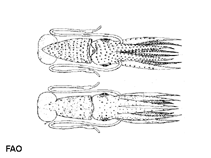Histioteuthis reversa (Verrill, 1880)
Elongate jewell squidWarning: DOMDocument::load(): SSL operation failed with code 1. OpenSSL Error messages: error:140770FC:SSL routines:SSL23_GET_SERVER_HELLO:unknown protocol in C:\Apache24\htdocs\includes\SpeciesSummary.lib.php on line 1236
Warning: DOMDocument::load(): Failed to enable crypto in C:\Apache24\htdocs\includes\SpeciesSummary.lib.php on line 1236
Warning: DOMDocument::load(https://sealifebase.nrm.se/webservice/AquaMaps/getAMap.php?genus=Histioteuthis&species=reversa): failed to open stream: operation failed in C:\Apache24\htdocs\includes\SpeciesSummary.lib.php on line 1236
Warning: DOMDocument::load(): I/O warning : failed to load external entity "https://sealifebase.nrm.se/webservice/AquaMaps/getAMap.php?genus=Histioteuthis&species=reversa" in C:\Apache24\htdocs\includes\SpeciesSummary.lib.php on line 1236
Classification / Names Common names | Synonyms | CoL | ITIS | WoRMS
| Oegopsida | Histioteuthidae
Environment: milieu / climate zone / depth range / distribution range Ecologia
Pelágico(a,os,as); intervalo de profundidade 0 - 4332 m (Ref. 106098). Temperate; 53°N - 22°S, 82°W - 37°E (Ref. 106965)
Distribuição Países | Áreas FAO | Ecossistemas | Ocorrências | Introduções
Atlantic, Gulf of Mexico, the Caribbean and the Mediterranean Sea.
Length at first maturity / Tamanho / Peso / Idade
Maturity: Lm ? range ? - ? cm Max length : 20.0 cm ML macho/indeterminado; (Ref. 104052)
Mainly feeds on osteichthyes (myctophids), followed by crustaceans (natantian), and occasionally on cephalopods. Bases their diet on pelagic nictemeral migrators (Ref. 106992).
Life cycle and mating behavior Maturidade | Reprodução | Desova | Ovos | Fecundidade | Larvas
Members of the class Cephalopoda are gonochoric. Male and female adults usually die shortly after spawning and brooding, respectively. Mating behavior: Males perform various displays to attract potential females for copulation. During copulation, male grasp the female and inserts the hectocotylus into the female's mantle cavity where fertilization usually occurs. Life cycle: Embryos hatch into planktonic stage and live for some time before they grow larger and take up a benthic existence as adults.
Referência principal
Referências | Coordenador | Colaboradores
Collins, M.A., C. Yau, L. Allcock and M.H. Thurston. 2001. (Ref. 1985)
Categoria na Lista Vermelha da IUCN (Ref. 130435)
Preocupação menor (LC) ; Date assessed: 05 May 2010
Categoria CITES (Ref. 108899)
Not Evaluated
CMS (Ref. 116361)
Not Evaluated
Ameaça para o homem
Utilização humana
| FishSource |
Ferramentas
Mais informação
Fontes da internet
BHL | BOLD Systems | CISTI | DiscoverLife | FAO(Publication : search) | Fishipedia | GenBank (genoma, nucleotídeo) | GloBI | Gomexsi | Google Books | Google Scholar | Google | PubMed | Árvore da vida | Wikipedia (ir para, procurar) | Registo zoológico
Estimates based on models
Preferred temperature
(Ref. 115969): 4.8 - 13.9, mean 13.2 (based on 271 cells).



